How to Master the Badminton Overhead Clear (Expert Tips for Malaysia)
The badminton overhead clear is a full length stroke that sends the shuttlecock deep into your opponent’s backcourt. Mastering this shot is essential because it helps you control the rally, creates time for you to recover, and strengthens your defence. The core of good overhead clear technique involves preparing early, maintaining a relaxed grip, using a full racket drop, pronating your forearm through impact, and recovering with a scissor kick. This guide is for kids, school players, and adults training in Kuala Lumpur, Selayang, Kepong, Air Panas, and nearby areas. Real improvement in your badminton overhead clear comes from clean mechanics and consistent footwork, not just arm power.
A badminton coach in Malaysia explains the overhead clear technique, common mistakes, and simple drills for players to achieve faster progress in Kuala Lumpur.

Overview of the Overhead Clear
Purpose, Tactics & Safety First
The main purpose of the badminton overhead clear is to reset a rally, push your opponent to their backcourt, and give yourself time to return to a balanced ready position. Tactically, you can hit a straight clear down the line or a cross court clear to move your opponent around. A high, deep shot is a defensive clear, used to buy recovery time. A flatter, faster shot is an attacking clear, designed to pressure their backcourt and set up a weaker return.
Before attempting full power clears, always warm up properly. Focus on dynamic stretches for your shoulders, elbows, and wrists to prepare the muscles and reduce the risk of injury. This is a crucial step for players of all levels, from kids in Selayang to adults in Petaling Jaya.

Stance, Prep & Footwork
The Foundation: Footwork & Body Position
Good clears start long before you swing. Begin from a balanced ready position. As your opponent hits the shuttle, perform a small split step to prepare your body to move explosively. To get to the rear corner, use a fast chasse (side step) or a cross step behind your body. It is crucial to get behind the shuttle early.
Turn your body side on, so your non racket shoulder points towards the shuttle. This loads your hips and trunk for rotation. Your body weight should be on your back foot. As you swing, transfer your weight forward using a scissor kick motion. This powerful leg action not only adds power but also helps you land in a balanced position, ready for the next shot.
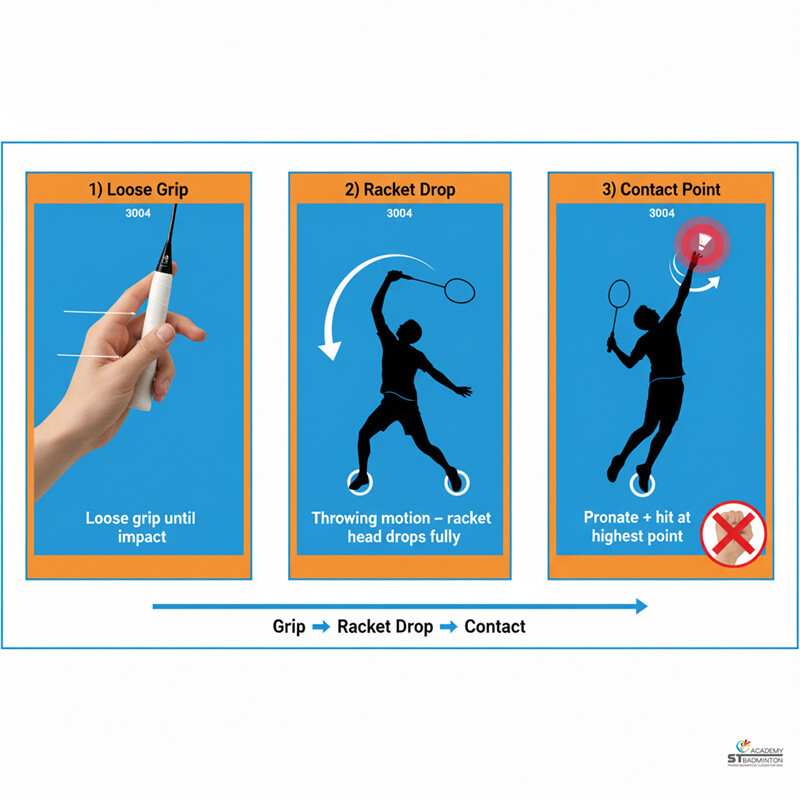
Grip, Racket Drop & Contact
The Swing: Grip, Drop & Contact Point
Hold the racket with a relaxed forehand (universal) grip. A tight grip will restrict your power and control. Loosen your fingers just before you start the forward swing. The key to power is a full racket drop. Let the racket head fall deep behind your back, similar to a throwing motion. Keep your elbow high and your chest open to maximise the range of motion.
As you swing forward, rotate your forearm inwards this is called pronation. Contact the shuttle at the highest comfortable point you can reach, slightly in front of your body. Hitting high and in front ensures the shuttle travels with a good trajectory. Finish the shot with a long, relaxed follow through across your body, and keep your eyes on the shuttle as it flies.
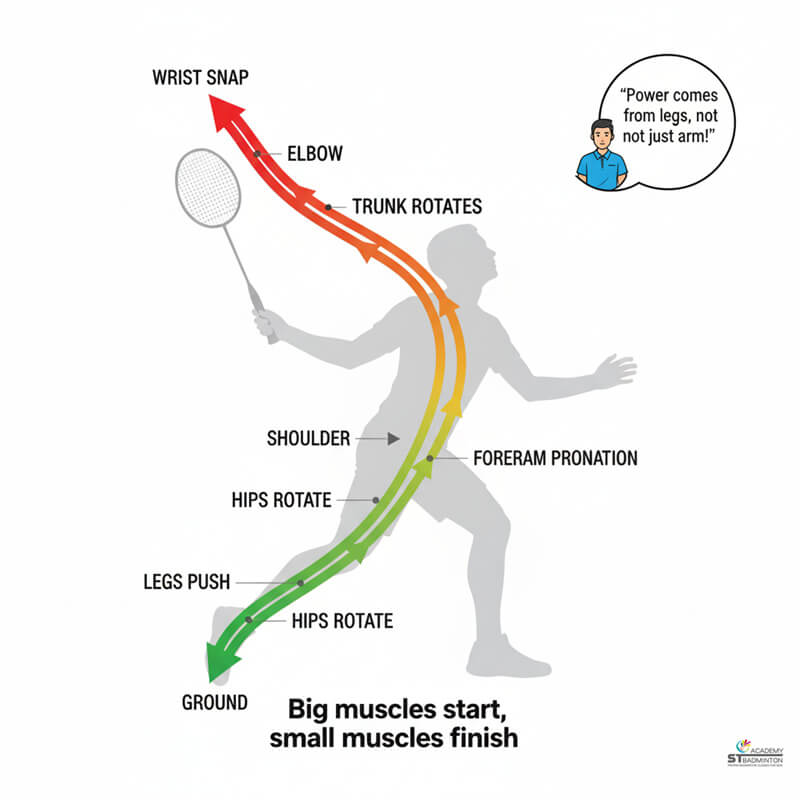
Power from the Kinetic Chain
Generating Power The Right Way
Effortless power in the overhead clear does not come from the arm alone; it comes from the whole body working together in a sequence known as the kinetic chain. The power starts from the ground up: first your legs push, then your hips and trunk rotate, which whips your shoulder, elbow, forearm, and finally your wrist through the shot. As a badminton coach in Malaysia, I always tell players: “Big muscles start, small muscles finish.”
To help with timing and relaxation, remember to breathe out as you make contact with the shuttle. Keep your shoulders relaxed throughout the swing. A tense body cannot transfer energy efficiently. By using the kinetic chain correctly, you can hit deep clears with less effort and more consistency.
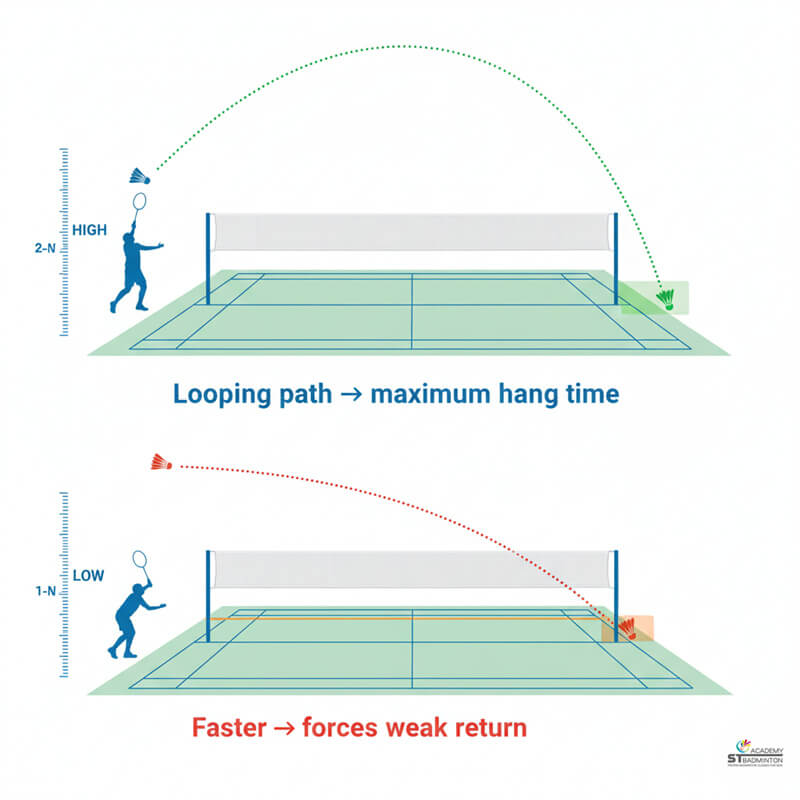
Shuttle Feel & Trajectory
Controlling the Shuttle’s Flight Path
Understanding how to control the shuttle’s trajectory is key to using the clear effectively. A high, deep defensive clear has a looping flight path, aiming to land as close to the opponent’s back line as possible. This gives you maximum time to recover your position.
In contrast, an attacking clear is flatter and faster, travelling just over your opponent’s reach to push them back and force a weak reply. You generate this flatter trajectory by hitting the shuttle slightly more in front of you and with more forward momentum.
A good player can hit both types of clears consistently. When you practise, aim for the deep corners, from tramline to tramline. Make sure to practise both straight clears and cross court clears to develop full control of the court.
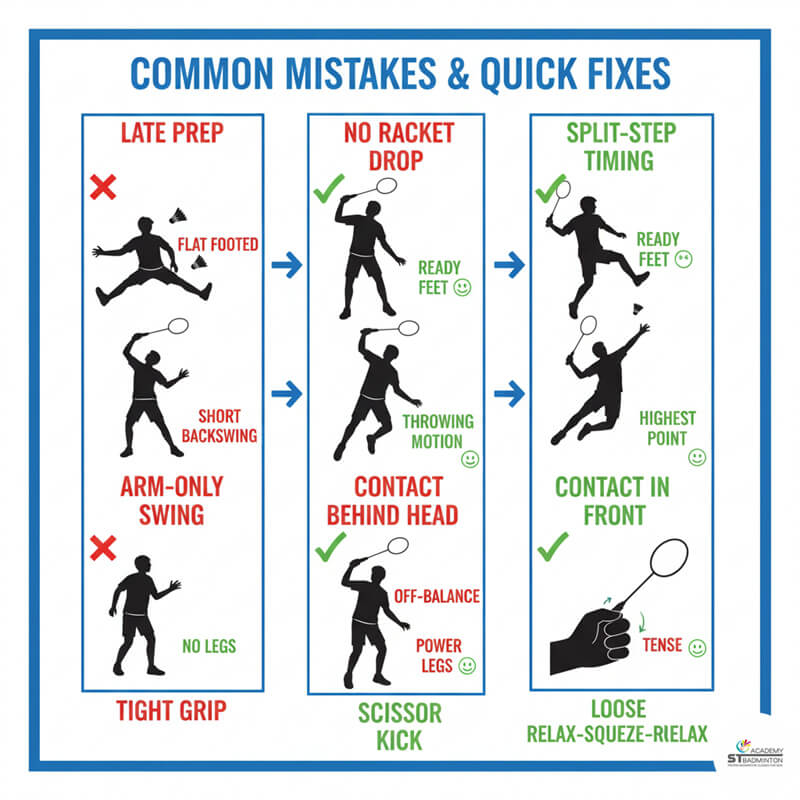
Common Mistakes & Quick Fixes
How to Fix Common Overhead Clear Errors
Many players struggle with the same issues. Here are some quick fixes for common overhead clear mistakes. Kids from Selayang and Kepong often struggle to send the shuttle deep because their timing is rushed.
- Late Preparation: If you’re always late, focus on your split step. Start it just as your opponent contacts the shuttle.
- No Racket Drop: If your clears are weak, it’s often due to a small swing. Practise shadow swings focusing on letting your elbow go up and the racket drop fully behind your head.
- Pure Arm Swing: If you feel tired quickly, you’re using only your arm. Add the scissor kick to feel your body rotating and generating power from the ground up.
- Contact Behind Head: This causes the shuttle to go up but not deep. The fix is to move earlier so you can contact the shuttle slightly in front of you. Keep your non racket arm up for balance and spacing.
- Tight Grip: A death grip kills power. Practise a “relax squeeze relax” sequence. Your grip should only tighten for a split second on impact.
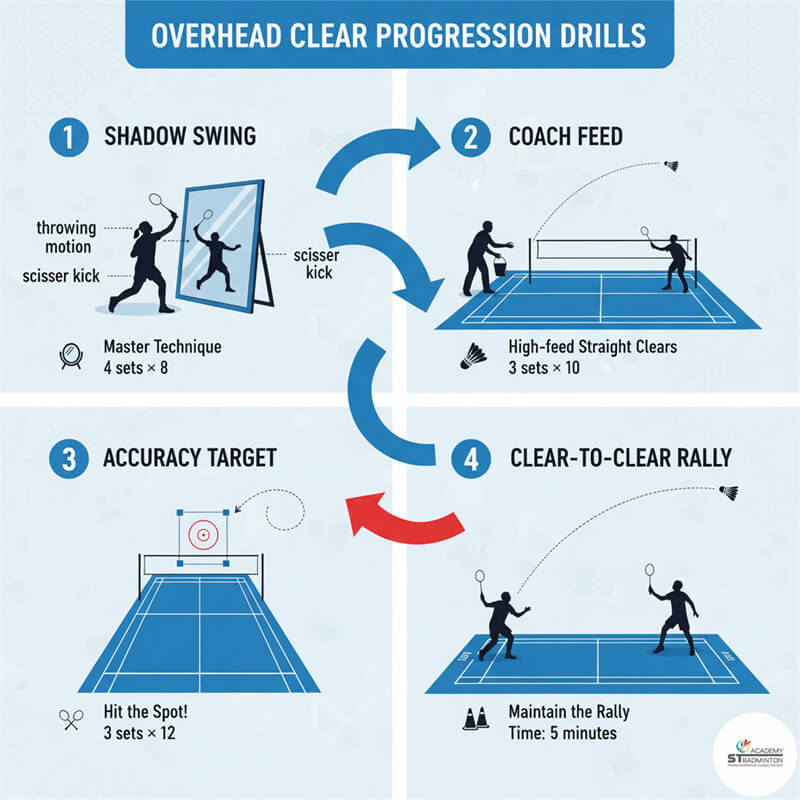
Progression Drills
Drills to Master the Badminton Overhead Clear
Use these drills to improve your technique. Focus on quality over quantity. Families around Air Panas often ask how to practise safely at home; the shadow and wall drills are perfect for this.
- Shadow + Cue Drill (10 reps): Practise the full motion side on turn, racket drop, pronation, scissor kick without a shuttle. Focus on smooth rhythm.
- High Feed Straight Clears (4 sets of 8): A coach or partner feeds high shuttles. Focus only on achieving good height and depth. Land balanced every time.
- Target Box Deep Corner (3 sets of 6): Place cones in the deep corners. Count how many shuttles you can land cleanly inside the box.
- Random Rear Corner Feed (3 sets of 10): Your partner feeds randomly to your backhand and forehand corners. Practise your footwork and decide whether to hit straight or cross-court.
- Clear to Clear Rally (5 x 1 min): Rally with a partner using only clears. Aim for consistency and try to keep the shuttle high and deep.
FAQs: Mastering the Badminton Overhead Clear
Here are answers to common questions from players in Malaysia about improving their overhead clear technique.
What is the quickest way to improve my badminton overhead clear?
The fastest way is to stop trying to hit hard and instead focus on correct mechanics. Many players believe power comes from the arm, but it really comes from timing and body rotation. Work on your footwork to get behind the shuttle early, ensure you have a full racket drop behind your head, and practise forearm pronation. A good badminton coach in Kuala Lumpur will tell you that a smooth, technically sound swing is more powerful and consistent than a rushed, arm only swing. Master the technique first, and the power will follow.
How can players in Kuala Lumpur practise overhead clear safely at home?
Even with limited space, you can improve your overhead clear technique at home. The best at home drill is the shadow swing. Stand in front of a mirror and practise the entire motion: side on turn, racket drop, pronation, and scissor kick recovery. This builds muscle memory without needing a shuttle. You can also do a wall toss drill by gently tossing a soft ball or shuttle against a wall to practise the throwing like rhythm and timing of your pronation. This is a safe and effective way to train on non court days.
Why does my clear land mid court even when I swing hard?
This is a very common problem. It’s usually caused by three technical errors, not a lack of strength. First, you might not be doing a full racket drop, which limits your swing arc. Second, you are likely using a stiff wrist and not pronating your forearm through the shot. Pronation adds a final snap of power. Third, you are probably contacting the shuttle too far behind your head. For a deep clear, the contact point must be high and slightly in front of your body. Focus on these three overhead clear tips to get more depth.
Is pronation necessary for a powerful overhead clear?
Yes, pronation is essential. It is the natural, inward rotation of your forearm during the swing. Think of it like turning a screwdriver. This movement happens very quickly at the point of impact and is a major source of racket head speed and power in the badminton clear technique. Without proper pronation, your shot will rely only on your shoulder and will be much weaker. It also helps you control the shuttle’s direction and angle, making it a critical skill for both clears and smashes.
How many drills should school players from Selayang do per week?
For school players from areas like Selayang or Kepong, the focus should be on quality, not just quantity. A good plan is to dedicate 15 to 20 minutes to clear specific drills two or three times a week. Instead of hitting hundreds of mindless shots, focus on perfect execution in smaller sets. For example, do 3 sets of 10 high feed clears focusing only on height, followed by 3 sets of 8 target box clears focusing on accuracy. This approach builds better habits and prevents fatigue related injuries compared to just rallying for an hour.
Can players from Air Panas with small courts still train depth?
Yes, absolutely. While a full sized court is ideal, players in places like Air Panas with limited space can still effectively train the mechanics for a deep clear. The most important drill is the shadow swing, which requires no court at all. You can also focus on wall drills, hitting a shuttle against a high wall to feel the contact point and pronation. When you do get on a court, focus every clear on a specific target in the back corners. This mindset of aiming for depth, even on a smaller court, builds the right habits.
Badminton Overhead Clear Technique in Action

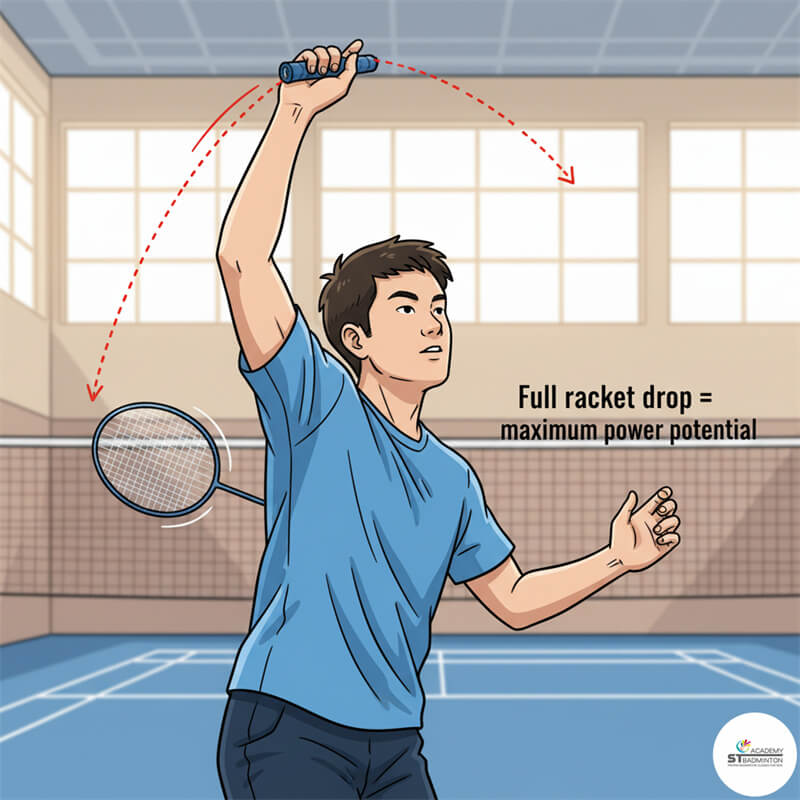
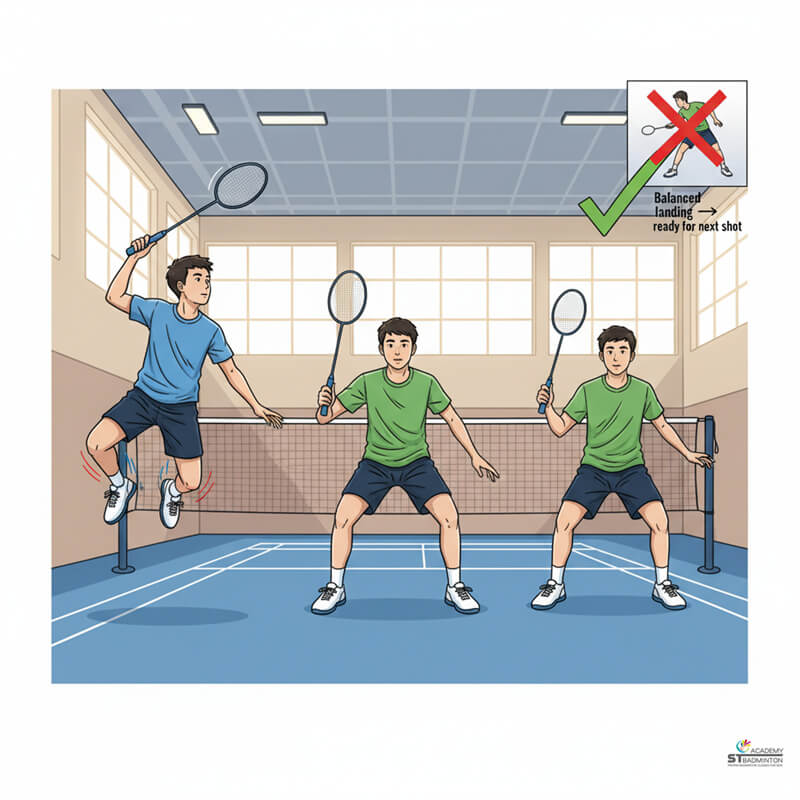
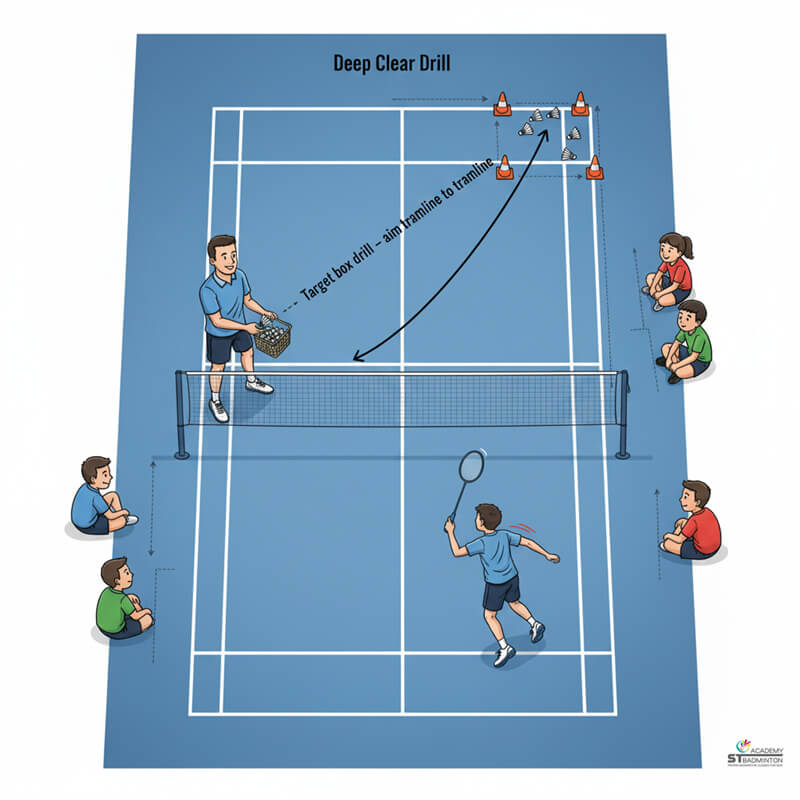
Benefits of Mastering the Overhead Clear Technique
Focusing on proper badminton clear technique provides huge advantages for your long term development, consistency, and safety on the court. Our technique first approach helps build a solid foundation for a powerful and reliable game.
| Performance Area | Swinging With Only Arm Power | Using the Full Kinetic Chain CORRECT |
|---|---|---|
| Power Source | Relies only on arm and shoulder muscles, which fatigue quickly. | Uses legs, hips, core rotation, and arm together for effortless power. |
| Consistency | Often lands short, out, or is hard to control under pressure. | Produces deeper, higher, and more accurate shots consistently. |
| Injury Risk | High risk of shoulder impingement, tennis elbow, and wrist strain. | Distributes the load across the whole body, making it much safer. |
| Recovery Speed | Player is often off-balance after swinging, leading to slow recovery. | Scissor kick and body rotation help with a fast, balanced recovery to base. |
| Deception | The swing movement is obvious and easy for the opponent to read. | The side-on turn helps disguise the shot until the last moment. |
| Long-Term Outcome | Power hits a plateau quickly and can lead to chronic pain issues. | Allows for continuous improvement and supports a long playing career. |
Ready to Improve Your Badminton Overhead Clear in Kuala Lumpur?
This guide provides the expert tips you need to master the badminton overhead clear. When you are ready to put this knowledge into practice, our academy is here to provide professional guidance. We offer in person badminton training in Kuala Lumpur with a focus on technique and consistency for serious learners. If you're looking for a badminton coach in Kuala Lumpur, contact us to learn about class schedules for players in areas like Setapak, Wangsa Maju, and Cheras.




